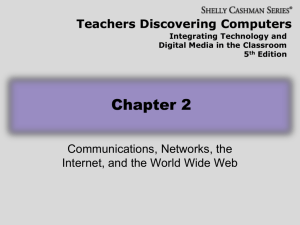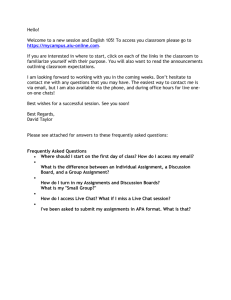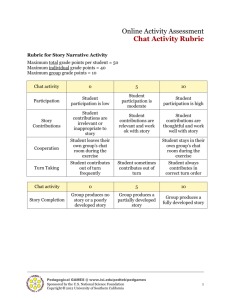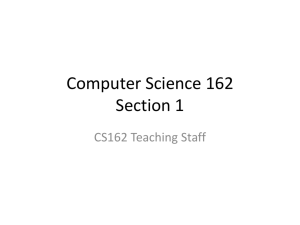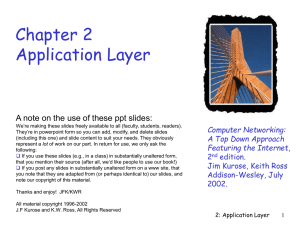part1a
advertisement
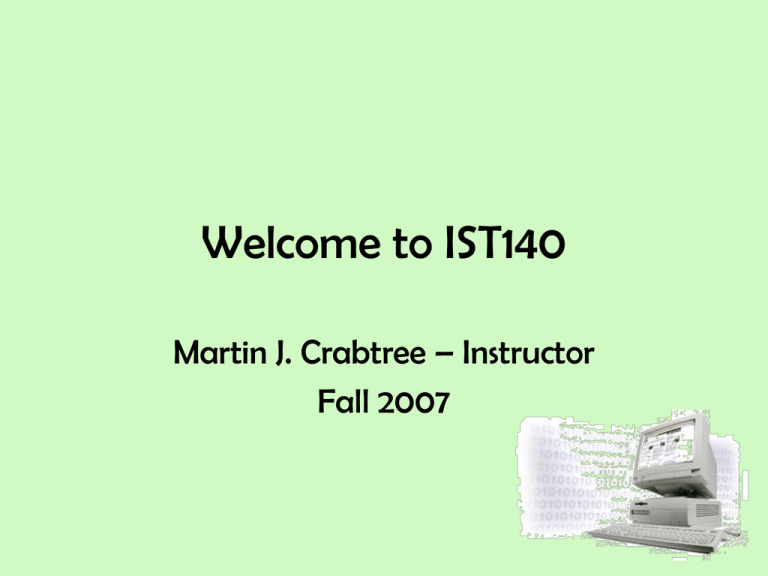
Welcome to IST140 Martin J. Crabtree – Instructor Fall 2007 Agenda • • • • • Greetings, syllabus, etc. What are you expecting from this course? What is the Internet? Internet definitions A bit on how the internet works – Transmission Control Protocol (TCP) – Internet Protocol (IP) – Domains • History of the internet IST140 – Important things you’ll nee • Text - Internet Literacy, 4th edition, by Fred Hofstetter • DO NOT Install FrontPage (on CD that comes with the textbook) until you’re told to do so!!! • You will need something to store/carry your work (floppy, CD, USB drive) What are you expecting from this course? So let’s get started… What is the internet? The Internet is… • A World wide connection of >285 million computers • Uses common Internet protocol (IP) • Developed by U.S. Department of Defense in 1969 to protect network data • Web pages increased from ~300 million in 1998 to ~300 billion in 2003 The Internet • The Internet is the fastest growing technology in history: – Radio too 38 years to gain 50 million listeners. – Television too 13 years to reach the 50 million mark. – The Internet took 4 years to reach 50 million • In 2005 there were 1.08 billion people using the Internet (total world population in 2005 was 6.45 billion people) The Internet is much more than just the web Internet ≠ The World Wide Web Internet ≠ The World Wide Web • The World Wide Web is information accessible via the Internet. • The World Wide Web contains documents and multimedia that are connected by hyperlinks. • The Internet is global collection of networked computers using internet protocols Let’s take a closer look at the internet… Go to: www.mccc.edu/~crabtrem/ist140/ex1.htm Some Internet Definitions We will talk about these in depth during this course The Internet includes a number of services • • • • • • • • • • E-mail Listserv Newsgroups Chat rooms Videoconferencing File transfer Multimedia streaming Rich site summary Blogging World Wide Web Electronic Mail - email • Most common Internet service • Mail queues hold both personal and business items • Unsolicited mail are increasing problem List Severs - Listserv • • • • Uses e-mail protocol Users must subscribe to list All users receive same email message There are 1,000s of listservs Newsgroups • Newsgroup subscribers use newsreaders to access a group’s news feed • Usenet is an electronic bulletin board • Newsgroups contain information on most any topic Chat • Popular real-time communication • Each chat room has a different conversation • You can join or create your own chat room Instant Messaging (IM) • Instant messaging allows you to contact friends or associates • An IM will appear on your screen when a contact is made • “IM” is both verb and noun Videoconferencing • Uses video camera and microphone • Less popular than text-only chat • Higher bandwidths will support future growth FTP • File Transfer Protocol • Standard method for transferring files over the Internet from one computer to another • “FTP” is both verb and noun FTP The author clicks the right arrow to FTP a file from his computer to McGraw-Hill. Multimedia Streaming • Digital transmission of multimedia • Uses memory buffer to distribute (“stream”) data • Radio and television stations broadcast live shows World Wide Web • WWW is a networked hypertext system • Hypertext uses underlined links to launch link objects • Invented in 1989 by Tim Berners Lee at CERN lab in Geneva, Switzerland World Wide Web • In 1993, NCSA released Mosaic graphical user interface • In 1994, Netscape released the popular Navigator browser • In 2003, Netscape promoted free, “open source” products Mozilla, Firefox, and Nvu Rich Site Summary (RSS) • RSS uses eXtensible Markup Language (XML) for handling Web site content • Popular Web format for distributing news headlines, project updates, and event listings Blogging • Term blog is short for web log • Written by different individuals to chronicle their selected topics for Internet dialog • Public directories and tools are available to create these “online diaries” How does the Internet work? What is TCP/IP? • TCP stands for Transmission Control Protocol – TCP is a protocol than handles packet routing over the Internet • IP stands for Internet Protocol – IP administers the sending and receiving of computer addresses IP Addresses • Unique for each Internet computer • Current IP addresses use dotted quad notation – Four 8-bit numbers separated by periods • Range 0.0.0.0 to 255.255.255.255 • Future IP addresses will use IPv6 – Four 16-bit numbers • Range 0 to 65,535 Domains and Subdomains • Domain name system (DNS) allows alphabetic addresses instead of numbers – For example, to access the Library of Congress, use 140.147.249.7 or www.loc.gov • Common top level domains are: – .edu – .int .gov .com .biz .net .mil .aero .org .pro A Brief History of the Internet Brief History of the Internet • The Internet originated in 1969 when DOD initiated ARPANET for network security • During 1970s, universities joined ARPANET for research opportunities • In 1983, the military switched to MILNET Internet History (cont.) • In 1986, the National Science Foundation began NSFNET to connect supercomputers • In 1991, commercial entities were allowed, speeding expansion greatly • Currently, U.S. backbone traffic is routed through network providers Next time • Chapter 2 – The Internet's effect on the world • Open book quiz – Chapter 1
